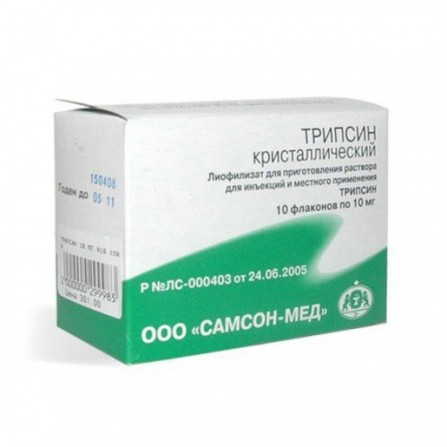Trypsin Crystalline Powder Lyophilized Injection Ampoule 10mg N10
Condition: New product
1000 Items
Rating:
Be the first to write a review!

More info
Active ingredients
Trypsin
Composition
Lyophilisate for preparation of solution for injections and local application of 1 amp. crystalline trypsin 10 mg.
Pharmacological effect
Crystalline trypsin is a proteolytic enzyme preparation derived from the pancreas of cattle. Trypsin has pronounced anti-inflammatory and anti-edematous properties, it is capable of splitting dead tissue, fibrinous formations, viscous secrets and exudates. In relation to healthy tissues, the enzyme is inactive and safe due to the presence of trypsin inhibitors (specific and nonspecific) in them. Does not affect the hemostatic system.
Indications
- bronchiectasis, lung abscesses, exudative pleurisy, postoperative atelectasis, empyema of the pleures - treatment of purulent wounds and burns - chronic purulent otitis, purulent sinusitis, sinusitis - acute thrombophlebitis - acute and chronic odontogenic osteo-helitas - acute thrombophlebitis - acute and chronic odontomal osteomyelitis - acute thrombophleitis , hemorrhages in the chamber of the eye and edema of the orbital tissues after injuries and operations, obstruction of the tear ducts.
Contraindications
- hypersensitivity - heart failure - pulmonary emphysema with respiratory failure - decompensated pulmonary tuberculosis - degeneration and cirrhosis of the liver - infectious hepatitis - kidney damage - pancreatitis - hemorrhagic diathesis.
Use during pregnancy and lactation
Use during pregnancy is possible only if the expected benefit for the woman outweighs the possible risk for both the woman and the child.
Dosage and administration
Crystalline trypsin is used intramuscularly, intrapleurally, in the form of aerosols and electrophoresis. Intramuscularly: Adults for 0.005-0.01 g - 1-2 times / day, for children - 0.0025 g 1 time / day. For injection dilute, directly before use, 0.005 g of crystalline trypsin in 1-2 ml of a 0.9% solution of sodium chloride or a 0.5-2% solution of procaine. The course of treatment is 6-15 injections. Electrophoresis with trypsin is also used: for one procedure, 10 mg of trypsin (dissolved in 15-20 ml of distilled water), injected from the negative pole. Inhalation: 0.005-0.01 g in 2-3 ml of 0.% chloride solution through an inhaler or through a bronchoscope.After inhalation, rinse your mouth with warm water and rinse your nose. Eye drops: 0.2-0.5% solution, which is prepared immediately before use, 3-4 times / day for 1-3 days. Intrapleurally: 1 time / day 10-20 mg of the drug, dissolved in 20-50 ml of 0.9% sodium chloride solution, after the introduction, frequent change of body position is desirable; on day 2 after instillation, as a rule, a liquefied exudate is released. Locally: in the form of powder or solution, compresses are applied to dry or necrotic wounds (the solution is prepared immediately before use: 50 mg of trypsin is dissolved in 5 ml of sterile water or saline, in the treatment of purulent wounds - in 5 ml of phosphate buffer solution). A three-layer woven dialdehyde cellulose fabric soaked in trypsin is applied to the wound (after it has been processed) and fixed with a bandage, left on the wound for no more than 24 hours. Before use, the fabric is moistened with distilled water or furatsilina solution. The time for complete cleansing of the wound from necrotic tissue and pus is 24-72 hours. If necessary, it is used again.
Side effects
Allergic reactions. Increased body temperature, tachycardia. Soreness and hyperemia at the injection site with the / m introduction. Inhalation of trypsin can cause irritation of the mucous membranes of the upper respiratory tract and hoarseness.
Interaction with other drugs
Only during inhalation can bronchodilators and antibiotics be added to the solution.
special instructions
You can not enter the drug in the foci of inflammation and into the bleeding cavity. You can not enter the drug in / in. Trypsin should not be applied to the ulcerated surfaces of malignant tumors in order to avoid the spread of the malignant process.


